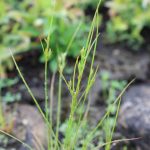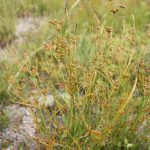Poverty rush
Prepared by Jennifer L. D’Appollonio, Assistant Scientist, University of Maine, Orono, ME 04469. Updated February 2018.
Scientific name: Juncus tenuis Willd.
Common name(s): poverty rush, path rush, slender rush
Link(s): USDA PLANTS Profile, NPIN Profile, Go Botany
Images: (to see enlargements [PC]: click on image, then right click and choose “view image”)
- early June
- early July
Description:
– perennial
– reproduces by seed
-Flowers June to September.
– one of two genera of rushes in ME; Juncus is not hairy, the other (Luzula) is hairy
-Tufted
-2″ to 30″ high
-Leaves at the base are very narrow and about half the height of the stem
-Flowers are less than 4″ high.
– may be confused with J. anthelatus (which has been shown to hybridize with J. tenuis in ME) or J. dichotomus. In Franklin and Penobscot Counties, ME, J. tenuis is also historically recorded as hybridizing with J. vaseyi; see left sidebar and Flora Novae Angliae information on Go Botany webpage
Habitat:
– tends to occur in disturbed areas (such as paths)
-meadows and fields
-shores of rivers
Natural History:
-used by the Cherokee to make a wash to strengthen babies
-used by the Iroquois to induce vomiting in athletes
Source(s):
Haines, A., Farnsworth, E., Morrison, G., & New England Wild Flower Society. (2011). New England Wildflower Society’s Flora Novae Angliae: A manual for the identification of native and naturalized higher vascular plants of New England. Framingham, MA: New England Wild Flower Society. p. 189.
Go Botany. “Juncus Tenuis Willd.” Juncus Tenuis (Path Rush): Go Botany, 2021, gobotany.nativeplanttrust.org/species/juncus/tenuis/.
Acknowledgement(s):
Eric T. Doucette, Ph.D. – Assistant Professor of Biology, MA College of Liberal Arts, North Adams, MA (updated Feb 2018)


